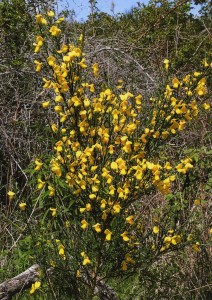There are many impressive waterside plants in the Highlands and they often form an impressive fringe to the edges of lochs and lochans. These include marsh marigolds, water mints and sometimes marsh orchids. Out on the water there can be impressive stands of common reed and the much smaller bog bean. Sedge beds along the fringes are used as nesting sites by the rare Slavonian grebe and the little grebe. Both build their floating nests that rise and fall with water levels unless the variations are too great and the nest and eggs get swamped. This is now considered one of the main causes for the decline in the Slavonian grebe in recent years at such places as Loch Ruthven. The presence of such a variety of waterside and aquatic plants is often a sign of the richness of a loch for insects and this is particularly the case with dragonflies.
There is another aquatic plant that has always intrigued me partly because compared with most of the others, if not all, they are the most robust and impressive. It is the great reedmace, often erroneously called the bulrush. Part of its attraction is that it comes into full growth, an impressive two metres tall, later than most plants and for the last few weeks has been at its best. Having contacted a local botanist I was told that the one place near Inverness to see the reedmace was on the waters edge at the Merkinch local Nature Reserve on the western side of the city. Then I was directed to Loch Kinellan just west of Strathpeffer and this must be the most westerly edge of the range in the northern Highlands. However, by chance I also found a small colony in the village of Cawdor to the east of Inverness. It is on the village green and was perhaps once the village pond although it is quite small at only a few yards across. A couple of weeks ago the reedmace were fully out and dominated the whole of the pond and looking very impressive.
 There are many plants in the Highlands that have been used for the traditional covering of roofs dating back centuries in time. Whilst in other parts of the UK reed is the favourite choice this is an uncommon plant in the Highlands despite the number of lochs. Accordingly people used whatever was at hand and the most popular, because it as so widespread, was heather. Other plants varied from broom, see photograph, to rushes and juniper to iris. One of the long list was the great reedmace which is not surprising considering the length and strength of the leaves. However its use for thatching must have been limited as it confined to the eastern parts of the Highlands around Inverness.
There are many plants in the Highlands that have been used for the traditional covering of roofs dating back centuries in time. Whilst in other parts of the UK reed is the favourite choice this is an uncommon plant in the Highlands despite the number of lochs. Accordingly people used whatever was at hand and the most popular, because it as so widespread, was heather. Other plants varied from broom, see photograph, to rushes and juniper to iris. One of the long list was the great reedmace which is not surprising considering the length and strength of the leaves. However its use for thatching must have been limited as it confined to the eastern parts of the Highlands around Inverness.
The uses of the reedmace has not been confined to thatching as it has a long history of culinary use. Interestingly it does not seem to have been mentioned at all by Richard Mabey in his famous book “Food for Free” first published in 1972. More recent books give it a good coverage although noting that for some unexplained reason nobody now collects this plant for food. Perhaps one of the problems is legislation as one of it delicacies is in the strange rope-like root. This contains a great deal of starch which can be eaten raw or baked to make a flour. The problem is that you cannot just uplift these without the owners permission which is perhaps just as well considering the rarity of the plant in the Highlands.
